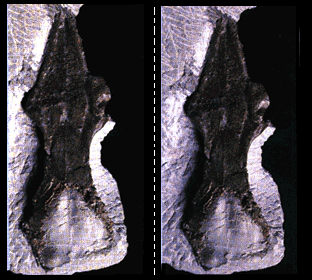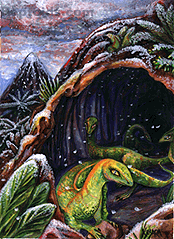![]()
THE POSSIBLE POLAR ORIGIN OF
REPTILIAN NON-HUMAN BEINGS
By John Rhodes
If one were to look anywhere on Earth for the location of the origin of the reptilian "alien" species, Antarctica appears to be a prime candidate for scientific investigation. It's remote and fairly inaccessible location has for many years made the task of scientific exploration an arduous and costly endeavor. New technology and renewed interest in Antarctica as a scientific frontier, however, has yielded new information that furthers our search for the possible terrestrial origin of the reptilian "alien" species.
Hundreds of millions of years ago, the Earth that the
dinosaurs inhabited look quite different than it does now. In fact, the entire
land mass of the Earth was drawn together by continental drift into one giant
supercontinent surrounded by a single ocean called Tethys. The continent itself
was called Pangaea.
After a while, Pangaea gradually split into two separate parts. The northern land mass (containing the North American, Asian and European continents) gradually fractured and spread northwards. The southernmost land mass (containing South America, Africa, India, Antarctica and Australia) remained fairly intact and occupied the southern hemisphere. This southern hemispheric land mass was called Gondwanaland.
At this time, Antarctica was attached to the southern boundary of Australia, forming an area that is known as polar Gondwanaland. Although polar Gondwanaland was located well within the Antarctic circle, the fossil records indicate that this area enjoyed a climate similar to that of the state of Oregon. Paleobotanists report that during this time in earth's history, Antarctica’s cool landscape was filled with beautiful conifers, ferns, evergreens and a few flowering plants which spread patches of color across the vast land. Geologists report that great mountain ranges and volcanoes pierced the horizon and rivers flowed abundantly across the terrain. What is most important, is that paleontologists have discovered that within this enchanting and peaceful polar environment a variety of animal life once lived...including dinosaurs.
The discovery of these "Polar Dinosaurs" afforded the paleontological circles a rare opportunity to learn more about the history of life on Earth. In addition, along the southern cliff side of Australia, a region that was once attached to polar Gondwanaland, the remains of another Polar Dinosaur was unearthed that provided insight into the remarkable ability of the dinosaur to evolve adapt and thrive in dark, cool environments. the dinosaurs name was LEAELLYNASAURA (Lee-Ellena-Saura):
 PRE-ADAPTATION TO THE UNDERWORLD
ENVIRONMENT.
PRE-ADAPTATION TO THE UNDERWORLD
ENVIRONMENT.
In 1987, Paleontologist Tom Rich of the Museum of Victoria, Australia; discovered the fossilized remains of one particular polar dinosaur in an excavated tunnel on the southern tip of Victoria (South Australia) in a place called Dinosaur Cove. When he found this hipsilophodontid dinosaur, he discovered a 106 million years old fossilized treasure that revealed the extent to which dinosaurs were able to adapt and survive in the extremes of light and temperature. This miraculous find was called Leaellynasaura, after his daughter.
Leaellynasaura was unique dinosaur in many ways. It was a large chicken sized herbivorous dinosaur with bipedal posture, long legs and well-developed hands at the end of their front limbs. They also had large eyes set into their heads.
Behind their eyes, an even more amazing thing was discovered...
 When Tom Rich discovered Leaellynasaura’s
skull (left), he noticed that it also had an unusually large brain for a
dinosaur of it's size and that it's optical lobes (the ridge of the brain where
messages are received from the eye and are translated into visual images) were
extremely oversized and the dinosaurs eyes were remarkably large. These cranial
formations led Dr. Rich to believe that a major portion (almost sixty-five
percent) of Leaellynasaura's brain was completely dedicated to the processing
optical information. ( Suggesting a dinosaur that is primarily nocturnal in
their activity cycles.)
When Tom Rich discovered Leaellynasaura’s
skull (left), he noticed that it also had an unusually large brain for a
dinosaur of it's size and that it's optical lobes (the ridge of the brain where
messages are received from the eye and are translated into visual images) were
extremely oversized and the dinosaurs eyes were remarkably large. These cranial
formations led Dr. Rich to believe that a major portion (almost sixty-five
percent) of Leaellynasaura's brain was completely dedicated to the processing
optical information. ( Suggesting a dinosaur that is primarily nocturnal in
their activity cycles.)
(Note: Place a card or piece of paper on the dotted line, bring your eyes close to the opposite end of the card or paper. Allow your focus to merge the two pictures. It can be seen in 3D! Special thanks to Quantas 'Airways' Syme projects for use of this image.)
Although Polar GondwanaLand had a climate much like that of northern Oregon or Scotland, Dr. Rich knew that the seasonal extremes through which the polar Gondwanaland environment fluctuated were as unique as were the dinosaurs that inhabited this ancient region of the planet. Any animal living in this southerly location would either have to migrate northwards during the four long months of winter cold and darkness or be physically adapted to living and thriving through such environmental extremes. Leaellynasaura had proven the later to be true.
Paleoclimatologists report that, even though the winter temperature fluctuations were not as dramatic then as they were millions of years ago, they were noticeable. During the four long, dark months of polar winter, dinosaurs would have had to forge for food in either freezing or sub-freezing temperatures. This means that Leaellynasaura-like dinosaurs may have had a warm-blooded physiology far superior to any those dinosaurs living beyond the northern polar Gondwanaland boundaries. The sheer environmental stresses of living under these polar climates may have encouraged dinosaurs living in this region to evolve an evermore increasingly warmer blooded physiology in order to survive
Together, these physical attributes answer the question as to the physical adaptability and physiological survivability of some of the dinosaurs in extreme environments. Gondwanaland dinosaurs, such as the lovely Leaellynasaura, were pre-adapted to living in dark, cool regions of the Earth...such as caverns and caves.
GOING, GOING.....DOWN
 There are several reasons why it is possible that some of
the polar dinosaurs may have been driven to seek the shelter of the Antarctic
underworld.
There are several reasons why it is possible that some of
the polar dinosaurs may have been driven to seek the shelter of the Antarctic
underworld.
1. Given that Leaellynasaura-type polar dinosaurs must have been hypersensitive to light, the long Antarctic summer days may have forced some dinosaurs into darker shelter in order to avoid bright light. As with most nocturnal animals, it is possible that they sought shelter in a cave or large caverns close to the surface of the earth.
2. The wind blown Antarctic winter nights may have also led the Leaellynasaura-like polar dinosaurs to seek shelter from the wind. Just as a cave or cavern opening became mankind's first domicile, dinosaurs may have used such an inner earth opening as a shelter from from such unfavorable winter conditions.
3. Many creatures that were on the Saurian menu, sought the refuge of the underworld to escape their predators. When caves and cavern systems were used as a means of escape, unrelenting dinosaurs would have followed their prey as deep into the earth as possible to get "dinner." Once inside, they may have noticed the agreeable conditions within the cave and later returned when winter draped itself over the Gondwanaland. terrain.
These environmental conditions may have possibly created a dinosaur that was perfectly pre-adapted for living underground. Furthermore, it is also important to remember that Leaellynasaura was almost 110 million years old when Paleontologist Tom Rich discovered its remains in Dinosaur Cove, Australia. This means that as physiologically advanced as these polar dinosaurs appear to have been, they still had an additional 45 million more years in which evolution could perfect their designs so that they could further explore their world and seek out new ecological niches in which they could adapt and thrive.
Paleontologists appear to be in agreement that dinosaurs of this type and from this region of the Earth were, most likely, amongst the last to walk the surface of the planet 65 million years ago.
Given the fact that this particular type of dinosaur was so highly adapted to a cool or cold climate and was able to see in the dark, could other advanced polar dinosaurs, such as Leaellynasaura, have been able to survive the cool, dark underground environment if they could find food and water? Could large brained dinosaurs have entered one of the many ancient volcanic vents or lava tube caves that speckle the southern Antarctic continent (polar Gondwanaland) and discovered an underground ecological niche in which they could evolve undisturbed for millions of years? As an answer to this question, one can only echo a very profound statement, written by the discoverers of Leaellynasaura, Patricia and Tom Rich, in Scientific American, July, 1993. Tom said:
 "Author Conan Doyle once dreamed
of a plateau in South America that time forgot, where dinosaurs continued to
reign. Reports earlier this year that Dwarf mammoths survived to early
historical times, in islands of the coast of Siberia, give force to such
speculation. If dinosaurs found a similar haven in which they outlived the rest
of their kind, then we think polar Gondwana, including southeastern Australia,
is a likely place to look for it."
"Author Conan Doyle once dreamed
of a plateau in South America that time forgot, where dinosaurs continued to
reign. Reports earlier this year that Dwarf mammoths survived to early
historical times, in islands of the coast of Siberia, give force to such
speculation. If dinosaurs found a similar haven in which they outlived the rest
of their kind, then we think polar Gondwana, including southeastern Australia,
is a likely place to look for it."
Alas, even these great paleontologists appear to also dream of discovering survivors of the great dinosaur extinction! And, according to their own words, they believe that polar Gondawanaland or Antarctica, would be the place to search for evidence of their survival.
Thanks to paleontologists Dale Russell and Tom Rich, immensely important realities have been established that can support the hypothesis regarding saurian survival. Scientific evidence indicates that: a) Dinosaurs may have eventually acquired the human-like physical form, b) Some dinosaurs were perfectly "suited" for survival in the dark, cool underground environment, and c) if the dinosaurs were to have survived, a yet undiscovered haven the Antarctic regions may conceal evidence of their survival.
Although scientists now concede that birds are, in fact, descendants of the dinosaurs (Colby Cosh, A Reptile with a beak, Vol. 23, Alberta Report/Western Report, 07-15-1996, page 24) there may be others saurian survivors that have not yet been discovered or "unearthed" from the sands of time. Furthermore, cold temperatures, that provided the killing blow to the majority of the saurian kingdom, may have preconditioned some of the dinosaurs and saved them from their ultimate final curtain!
FACTOID: Most people are under the impression that all reptiles are born hatched from eggs. For the most part, this is true. BUT, there are lizards that give birth to live young. It is called VIVIPARITY, defined as "retention of the developing embryo within the uterus until development is complete." (The Evoltuion of Viviparity in Lizards, BioScience, Vol. 43, No. 11.) Why did some of the lizard family begin to retain their embryo within the uterus instead of laying an egg? It is thought that the evolution of vivaparity may have been due to an ecological force such as cold climates. (Within the uterus, body temperatures insure continued warmth of the developing embryo.) Could the polar dinosaurs have been viviparous dinosaurs? Did they give birth to live young as do humans? One wonders.....